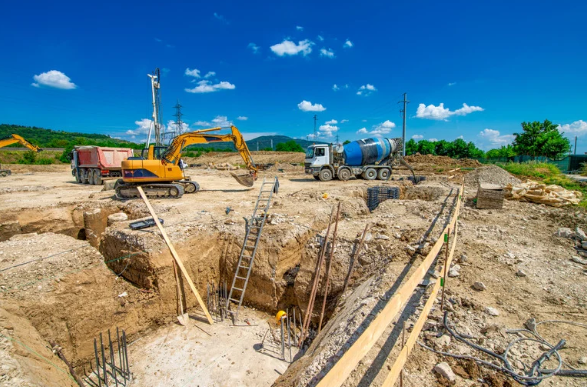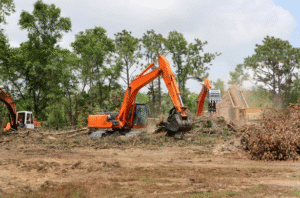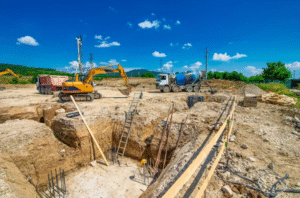Properly preparing your land is a vital first step toward a smooth and safe construction project. Whether building a home, developing commercial property, or setting up a new facility, the land must be cleared, shaped, and stabilized to support the structure. Understanding the land preparation process helps property owners plan effectively, avoid costly delays, and ensure the longevity of their investment.
What Is Involved in Preparing Land for Construction?
Preparing land for construction involves a series of steps that transform raw land into a stable, buildable site. This process includes clearing vegetation and obstacles, excavating soil, leveling the ground, compacting soil, and installing drainage systems. Each task plays a critical role in reducing risks associated with unstable soil, poor drainage, or unsuitable terrain conditions.
Why Is Land Preparation So Important?
-
Creates a Strong Foundation: Proper soil preparation reduces the chances of structural damage caused by soil settling or shifting.
-
Manages Water Effectively: Grading and drainage systems help direct water away from the building, preventing erosion and water damage.
-
Allows Safe Access: Clearing vegetation and obstacles provides space for construction equipment and workers to operate safely.
-
Ensures Compliance: Meeting local building codes and environmental regulations often requires thorough site preparation.
Step-by-Step Process of Land Preparation for Construction
Understanding each stage of the process can help property owners have realistic expectations and better communicate with their contractors.
Clearing Vegetation and Debris
The first major step involves removing trees, brush, rocks, and any debris that could interfere with construction. This creates a clear workspace and removes fire hazards or pest habitats that may be present on the property.
Excavation and Earthmoving
Excavation includes digging foundations, trenches for utilities, or removing unstable soil. Earthmoving may be necessary to shift dirt from one area to another to achieve the desired site grade.
Grading and Leveling the Land
Grading involves reshaping the land to create an appropriate slope for water drainage and to establish a flat or gently sloped surface for the building foundation. Proper grading prevents water accumulation and reduces soil erosion.
Soil Compaction
Once grading is complete, soil compaction increases the density of the soil, improving its load-bearing capacity. Compacted soil helps prevent unwanted settling, which can cause cracks or foundation damage.
Installing Drainage Systems
Drainage elements, such as French drains, swales, or gutters, are installed to manage water flow and protect both the foundation and landscaping from excess water.
Final Cleanup and Preparation
The last step involves removing any remaining debris and preparing the site for the construction team. This may include creating access points or temporary roads for machinery.
What to Expect When Preparing Your Land
The Value of Professional Expertise
Experienced land preparation contractors bring valuable knowledge about soil types, grading standards, and local regulations. Their expertise can save time and money by preventing errors and ensuring the process meets all requirements.
Cost Factors to Consider
Various elements impact the cost of land preparation:
-
Size and topography of the site
-
Density and type of vegetation to be cleared
-
Extent of excavation and grading needed
-
Soil conditions and compaction requirements
-
Drainage installation and related permits
Requesting a detailed quote that includes all potential expenses helps avoid surprises.
Typical Timeframe for Completion
The timeline depends on the size and complexity of the property. Smaller residential lots generally take several days, while larger commercial projects or sites with challenging terrain may take weeks.
Environmental and Regulatory Concerns
Many contractors now employ environmentally responsible techniques, such as erosion control and sediment management, to minimize negative impacts. Compliance with regulations protects both your property and local ecosystems.
Benefits of Thorough Land Preparation
| Benefit | Importance |
|---|---|
| Strong Structural Base | Prevents foundation problems from soil instability |
| Proper Water Control | Reduces risk of flooding and erosion |
| Safe Working Conditions | Keeps work zones clear and lowers accident risks |
| Regulatory Compliance | Avoids fines and construction delays by meeting building codes |
How to Ready Your Property for Preparation
-
Clearly mark underground utilities and irrigation lines to avoid damage.
-
Point out trees or vegetation you wish to preserve.
-
Remove any vehicles, equipment, or personal belongings from the site.
-
Communicate your expectations and timeline with your contractor.
-
Verify plans for debris removal or site restoration after preparation.
Common Questions About Land Preparation
How long does land preparation usually take?
Duration depends on project scope but typically ranges from a few days for small lots to several weeks for complex sites.
Will site preparation affect existing landscaping?
With proper planning, many landscape features can be preserved during clearing and grading.
Are permits needed before preparation?
Most jurisdictions require permits for grading, excavation, or drainage work. Your contractor can provide guidance on these requirements.
Can I prepare the land myself?
DIY preparation is feasible for small, simple lots, but larger or more complex properties benefit greatly from professional services for safety and efficiency.
Final Thoughts on Preparing Land for Construction
Proper land preparation is a foundation on which your entire construction project depends. Clearing, grading, compacting, and installing effective drainage help protect your investment and ensure lasting stability.
Choosing skilled contractors and maintaining open communication throughout the process will help your project stay on schedule and within budget. By taking the time to prepare your land correctly, you set the stage for a successful build that stands strong for years to come.




